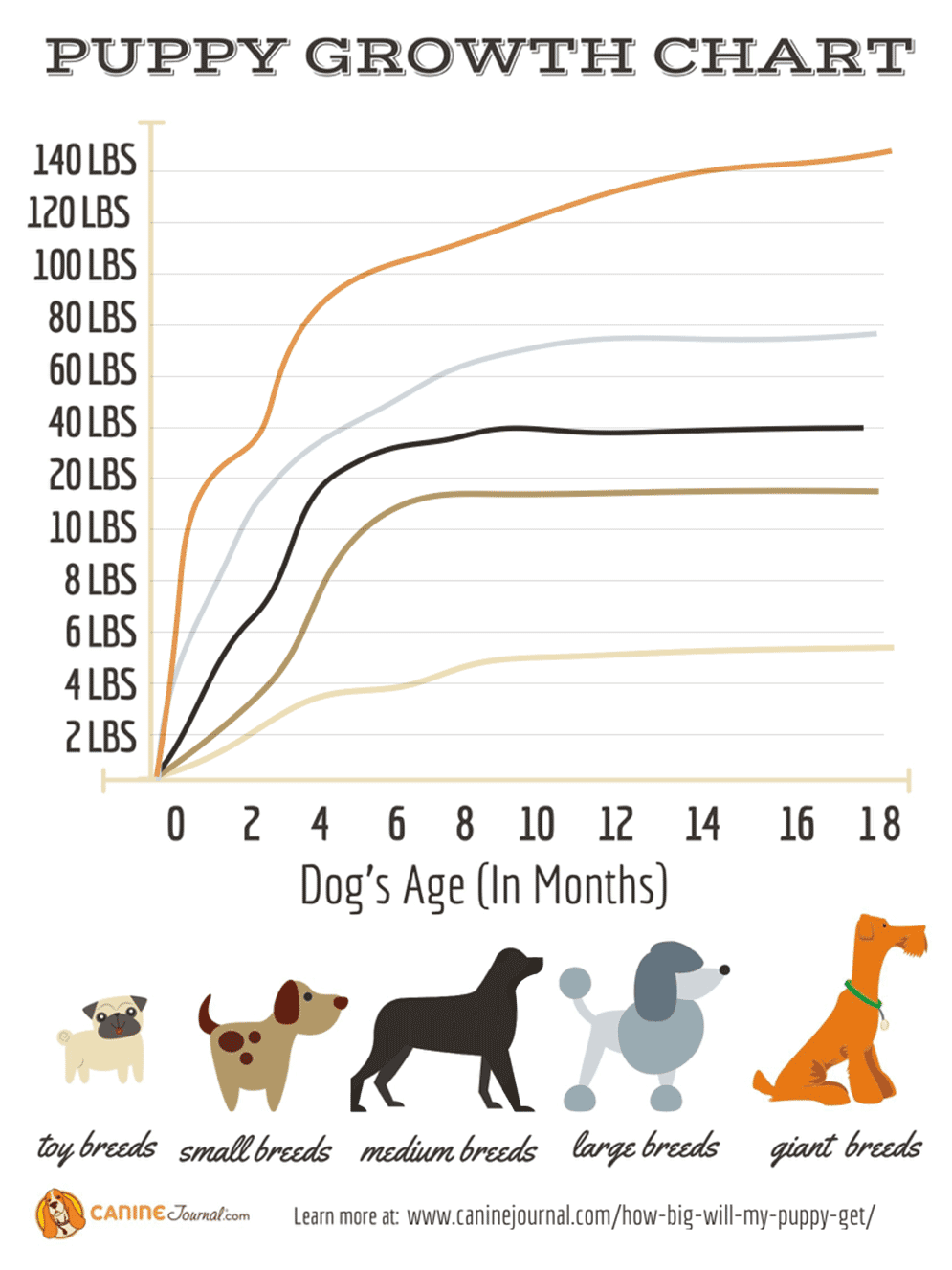When you purchase through links on our site, we may earn a commission. Here’s how it works.

How big will my puppy be? Dog size prediction is one of the most common questions new dog owners have for veterinarians and breeders alike. Learning how to tell how big a dog will get helps you plan ahead for a crate, collar, fencing in your yard, and other future needs.
We tell you some of the factors that affect a puppy’s growth, as well as handy formulas you can use to predict your pup’s adult weight and height. But please keep in mind that these are all rough estimates and aren’t always accurate. You could end up with a much bigger or smaller dog than you anticipated!
How Big Will My Puppy Get?
In general, an adult average-sized dog at 12 months old weighs about 2-1/2 times their weight at 14 weeks or twice their weight at four months of age. But these are over-generalized estimates that don’t take some other factors into account, including:
- Breed: Dogs’ growth rates and full-grown size vary widely by breed type. See our section below that breaks down breed sizes.
- Parents: If you’re lucky enough to see your puppy’s parents, you can get a pretty good idea of how big your puppy will get based on their sizes.
- Gender: As with humans, male puppies will typically be larger than females.
- Neutering/Spaying: Puppies that are neutered or spayed early can weigh a bit more and be slightly taller than average as adults. Why? The procedure can somewhat alter the chemical signals that tell the body to stop growing on its normal path.
Puppyhood Is The Best Time To Consider Pet Insurance
As a puppy, your dog has probably not shown any significant health concerns at a young age. Since pet insurance companies do not cover pre-existing conditions, the younger your dog is when you sign up, the better coverage you will likely receive throughout his lifetime. Further, pet insurance can help support you financially during the unpredictable puppy years when dogs are more likely to chew on things they shouldn’t and run into dangerous situations. Check out our pet insurance 101 guide to learn more and determine whether pet insurance is worth it for your puppy. Use our tool below to get multiple quotes instantly.
Is Paw Size A Good Puppy Weight Predictor?
You may have heard that a puppy’s paw size can give you an idea of how big your puppy will get, but that’s not always an accurate predictor. Why? Paw size can depend on the breed. For example, there are some large dog breeds, like Collies, that have small paws for their size. And some small to medium-sized breeds, like Bulldogs, have large paws for their size.
Dog Weight Estimator By Breed Size
As we mentioned above, a dog’s growth rate varies by breed. So there are different formulas to predict their adult weight by the general breed size. Dog breeds are generally broken into five categories by size, but keep in mind there is some overlap with dogs on the lower and higher end of each category.
- Toy (up to 12 pounds)
- Small (12-25 pounds)
- Medium (25-50 pounds)
- Large (50-100 pounds)
- Giant (over 100 pounds)
Toy Breeds
Toy breeds develop faster than larger breeds and stop growing between 8 and 9 months of age. Most of their growth happens between 0-11 weeks. On average, they gain about 5-10% of their body weight daily (roughly 1-5 oz per week). To best predict a toy’s adult size, you’ll want to take their 6-week weight, double it and then double it again. So a puppy who weighs 2 pounds at 6 weeks will weigh approximately 8 pounds as an adult (2×2=4, 4×2=8).
Some popular toy breeds include the Chihuahua, Maltese, Pekinese, Pomeranian, Shih Tzu, Toy Poodle, and Yorkshire Terrier.
Small Breeds
Small breeds typically stop growing between eight and 12 months. Like toy breeds, most of their growth occurs between 0-11 weeks. They gain about 5-8 ounces each week. You can apply the same formula you use for toy breeds to predict their adult weight: take their six-week weight, double it and double it again.
Some popular small breeds include the Beagle, Dachshund, French Bulldog, Jack Russell Terrier, Pug, Shetland Sheepdog, and West Highland White Terrier.
Medium Breeds
Medium-sized breeds usually reach their adult weight between 9 and 12 months of age, with the most rapid growth occurring between 0-16 weeks. To calculate medium-sized breeds, take their weight at 14 weeks, multiply that by 2 and add that figure to 1/2 of their 14-week weight. So if your puppy weighs 14 pounds at 14 weeks: 14×2=28, 28+7=35 pounds.
Some popular medium breeds include the Basset Hound, Border Collie, Bulldog, Cocker Spaniel, English Springer Spaniel, Staffordshire Bull Terrier, and Whippet.
Large Breeds
Large breeds can take from 12 to 18 months to reach their adult weight and height, with the most rapid growth occurring between 0-20 weeks. To calculate their adult weight, there are two methods you can use:
- Divide their weight at 20 weeks by their current age in weeks and multiply by 52. So for a puppy who weighs 35 pounds at 20 weeks: 35÷20=1.75, 1.75×52=91 pounds.
- Simply double their weight at 6 months of age.
Some popular large breeds include the Boxer, Bloodhound, Doberman Pinscher, German Shepherd, Golden Retriever, Labrador Retriever, Rottweiler, and Standard Poodle.
Giant Breeds
Giant breeds typically take 12-18 months to finish growing, but some can take up to 2 to 3 years before they reach their full adult size. The most rapid growth occurs between 0-25 weeks. The calculation method for giant breeds is the same as for large breeds:
- Divide their weight at 20 weeks by their current age in weeks and multiply by 52. So for a puppy who weighs 45 pounds at 20 weeks: 45÷20=2.25, 2.25×52=117 pounds.
- Double their weight at 6 months of age.
Some popular giant breeds include the Great Dane, Irish Wolfhound, Mastiff, Newfoundland, and Saint Bernard.
What If You Don’t Know The Breed?
How big will my mixed-breed puppy get? Well, this is more complicated if you have a mixed breed or don’t know the breed makeup of your dog. In the latter case, you can always consider doing a dog DNA test to determine his breed makeup (you’ll want to do a DNA test ASAP since results can take a few weeks).
Also, if you adopt a puppy from a shelter, they may be able to give you some idea of the suspected breed makeup.
How To Predict A Dog’s Height
To predict your puppy’s adult height, measure his height in inches at 6 months of age. Then multiply this figure by 100 and divide that answer by 75 (or simply multiply the 6-month height by 1.33). In other words, puppies achieve about 75% of their adult height at 6 months old.
A dog’s height is measured from the top of their shoulders to the floor (not the top of their head like we do for humans). Measure your dog on a flat surface and make sure he’s fully upright and his legs are vertical rather than splayed out.
When Do Dogs Stop Growing: Puppy Growth Chart

We have covered this topic in much more detail in our article about when do dogs stop growing.
Canine Genetic Age Testing With EasyDNA
Want to learn more about your pet? EasyDNA has made it easy to discover your dog’s actual age with a Canine Genetic Age test. It measures a dog’s telomeres’ length at a genetic level. It then uses that information to compare your dog to more than other breeds in its database to better define your dog’s breed and biological age. Order a kit, send in your sample, and get the results back in two to three weeks. Visit EasyDNA’s website to learn more and buy a test.
What Do I Need To Consider For An Adult Dog?
Now that you have a general idea about how big your puppy will get, you have a better idea of the size of collar and crate he’ll need once he’s an adult. See our handy guide on dog collar sizing and fitting, which also includes the average neck sizes for 100+ breeds.
Tagged With: Aging

